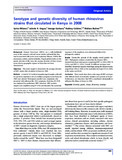| dc.contributor.author | Milanoi, Sylvia | |
| dc.contributor.author | Ongus, Juliette R | |
| dc.contributor.author | Gachara, George | |
| dc.contributor.author | Coldren, Rodney | |
| dc.contributor.author | Bulimo, Wallace | |
| dc.date.accessioned | 2016-05-26T13:54:12Z | |
| dc.date.available | 2016-05-26T13:54:12Z | |
| dc.date.issued | 2016 | |
| dc.identifier.citation | Influenza and Other Respiratory Viruses Volume 10, Issue 3, pages 185–191, May 2016 | en_US |
| dc.identifier.uri | http://onlinelibrary.wiley.com/doi/10.1111/irv.12373/full | |
| dc.identifier.uri | http://hdl.handle.net/11295/95955 | |
| dc.description.abstract | Background
Human rhinoviruses (HRVs) are a well-established cause of the common cold and recent studies indicated that they may be associated with severe acute respiratory illnesses (SARIs) like pneumonia, asthma, and bronchiolitis. Despite global studies on the genetic diversity of the virus, the serotype diversity of these viruses across diverse geographic regions in Kenya has not been characterized.
Objectives
This study sought to characterize the serotype diversity of HRV strains that circulated in Kenya in 2008.
Methods
A total of 517 archived nasopharyngeal samples collected in a previous respiratory virus surveillance program across Kenya in 2008 were selected. Participants enrolled were outpatients who presented with influenza-like (ILI) symptoms. Real-time RT-PCR was employed for preliminary HRV detection. HRV-positive samples were amplified using RT-PCR and thereafter the nucleotide sequences of the amplicons were determined followed by phylogenetic analysis.
Results
Twenty-five percent of the samples tested positive for HRV. Phylogenetic analysis revealed that the Kenyan HRVs clustered into three main species comprising HRV-A (54%), HRV-B (12%), and HRV-C (35%). Overall, 20 different serotypes were identified. Intrastrain sequence homology among the Kenyan strains ranged from 58% to 100% at the nucleotide level and 55% to 100% at the amino acid level.
Conclusion
These results show that a wide range of HRV serotypes with different levels of nucleotide variation were present in Kenya. Furthermore, our data show that HRVs contributed substantially to influenza-like illness in Kenya in 2008. | en_US |
| dc.language.iso | en | en_US |
| dc.rights | Attribution-NonCommercial-ShareAlike 3.0 United States | * |
| dc.rights.uri | http://creativecommons.org/licenses/by-nc-sa/3.0/us/ | * |
| dc.subject | Diversity | en_US |
| dc.subject | Genetic | en_US |
| dc.subject | Kenya | en_US |
| dc.subject | Rhinovirus | en_US |
| dc.subject | Serotype | en_US |
| dc.title | Serotype and genetic diversity of human rhinovirus strains that circulated in Kenya in 2008 | en_US |
| dc.type | Article | en_US |



